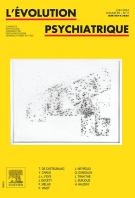Du processus psychique de transformation d’enfants en soldats : une clinique de la janissarisation - 13/04/25
On the psychological process of transforming children into soldiers : A janissarization process
 : Psychologue clinicien, Chercheur associé, Chargé de cours, Daniel Derivois b, ⁎
: Psychologue clinicien, Chercheur associé, Chargé de cours, Daniel Derivois b, ⁎  : Psychologue clinicien, Professeur des Universités en psychologie clinique et psychopathologie
: Psychologue clinicien, Professeur des Universités en psychologie clinique et psychopathologieRésumé |
Objectifs |
Cet article porte sur le processus d’enrôlement et de transformation d’enfants en soldats au Congo. Il analyse les mécanismes psychiques à l’œuvre dans cette dynamique.
Méthode |
Dans le cadre d’un projet de l’Unicef (DDR-Démobilisation, Désarmement, Réintégration), de nombreux enfants (9–17 ans) associés aux forces et groupes armés ont été rencontrés plusieurs fois (5 entretiens par enfant) dans des Centres de transit et d’orientation (CTO) à leur retour des zones de combat. Une grille d’entretiens a été construite qui permet d’explorer leur situation familiale avant l’enrôlement, les motifs, leur récit du séjour dans les groupes armés et les raisons de leur maintien dans les groupes armés. Cet article met l’accent sur six cas emblématiques.
Résultats |
Le processus de transformation d’enfants en soldats s’appréhende au travers de ce que nous proposons d’appeler processus de janissarisation. Ce processus traduit la récupération des effets des catastrophes sociétales à des fins de transformation active d’enfants/d’adolescents en soldats au moyen de la subversion des processus de maturation habituels de l’appareil psychique : remaniement psychique en lien avec la puberté, choix d’objet génital et détournement du système référentiel (et de l’idéal) dans lequel s’opèrent ces différentes mutations.
Discussion |
La discussion porte sur la démarche de la part du chef de guerre qui comprend le retournement des symboles structurants du groupe-communauté, le développement d’un lien d’attachement paradoxal au chef de guerre, l’instrumentalisation de la figure de l’intrus et enfin la mise en place d’une scénalité monstrueuse victime–bourreau. La figure de l’enfant soldat s’appuie fortement sur celle, plus commune, de l’enfant intrus. Les principales différences entre ces deux figures se situant dans la levée de l’interdit du meurtre et dans la mise en place d’une scénalité bourreau–victime.
Conclusion |
La janissarisation est ainsi un processus actif, qui concerne la manipulation du symbolique, une opération active de formation et de détournement de l’univers de sens, des codes et de l’idéologie du groupe. Quels que soient leurs modes d’enrôlement, les enfants/adolescents-soldats concernés par ce processus nécessitent un accompagnement soutenu et adapté qui les libère des conflits armés.
Le texte complet de cet article est disponible en PDF.Abstract |
Objectives |
This article focuses on the process of enlisting and transforming children into soldiers in Congo. It analyzes the psychological mechanisms at work in this dynamic.
Method |
As part of a Unicef project (DDR-Demobilization, Disarmament, Reintegration), many children (9–17 years old) associated with armed forces and groups were met several times (five interviews per child) in Centers for Transit and Orientation (CTO) upon their return from combat zones. An interview grid was constructed which allows us to explore their family situation before enlistment, their motives, their account of their stint in the armed groups, and the reasons for remaining in the armed groups. This article focuses on six emblematic cases.
Results |
The process of transforming children into soldiers is understood through what we propose to call the process of Janissarization. This process reflects the recuperation of the effects of societal catastrophes with the aim of actively transforming children/adolescents into soldiers by means of the subversion of the usual maturation processes of the psychic apparatus: psychic rearrangement in connection with puberty, choice of genital object, and redirection of the referential system (and of the ideal) in which these different mutations take place.
Discussion |
The discussion focuses on the warlord's approach, which includes the reversal of the structuring symbols of the group-community, the development of a paradoxical bond of attachment to the warlord, the instrumentalization of the figure of the intruder, and finally the establishment of a monstrous victim-executioner scene. The figure of the child soldier is strongly based on the more common figure of the intrusive and unwanted child. The main differences between these two figures lie in the lifting of the ban on murder and in the establishment of an executioner-victim scenario.
Conclusion |
Janissarization is thus an active process, which concerns the manipulation of the symbolic, and an active operation of creating and then hijacking a universe of meaning, codes, and ideology within the group. Whatever their modes of enlistment, the child/adolescent soldiers concerned by this process require sustained and adapted support that frees them from armed conflicts.
Le texte complet de cet article est disponible en PDF.Mots clés : Syndrome victime–délinquant, Enfant intrus, Janissarisation, Ancestralité, Pubertaire, Enfant soldat
Keywords : Victim–offender syndrome, Child intruder, Janissarization, Ancestrality, Puberty, Child soldier
Plan
Bienvenue sur EM-consulte, la référence des professionnels de santé.
L’accès au texte intégral de cet article nécessite un abonnement.
Déjà abonné à cette revue ?

